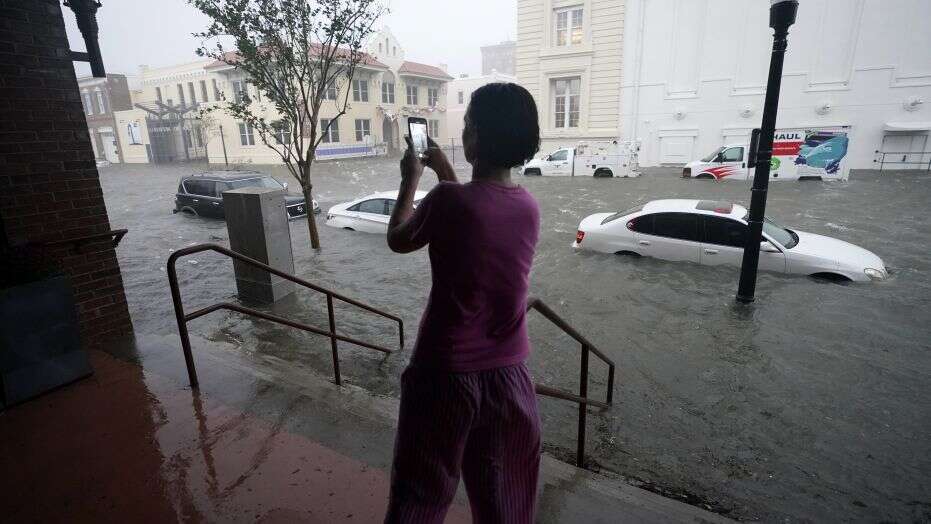PENSACOLA — Hurricane Sally made landfall Wednesday near Gulf Shores, Alabama, as a Category 2 storm, pushing a surge of ocean water onto the coast and dumping torrential rain that forecasters said would cause dangerous flooding from the Florida Panhandle to Mississippi and well inland in the days ahead.
Moving agonizingly slowly at less than five kilometres per hour, Sally finally came ashore at 4:45 a.m. local time with top winds of 102 mph, the U.S. National Hurricane Center said. Sally’s northern eyewall had raked the Gulf Coast with hurricane-force winds and rain from Pensacola Beach, Fla., westward to Dauphin Island, Alabama for hours before its center finally hit land.
Sally was downgraded to a Category 1 hurricane by late this morning by the hurricane center as its maximum sustained winds had decreased to 80 mph, with additional weakening of wind speed expected as the storm moves farther inland.
As of 11 a.m. ET, the storm was centered 12 miles west-northwest of Pensacola, Florida and moving north-northeast at 4.35 miles per hour.
With Hurricane Sally moving slowly and lashing the Gulf Coast with wind and rain, some local officials said the worst may be yet to come.
Escambia County Sheriff David Morgan said thousands of people in the communities he serves around Pensacola will likely be subject to evacuation orders from rising water in the coming days.
Morgan said deputies had already rescued more than 40 people by late Wednesday morning, including a family of four that was in a tree and was brought to safety with a high-water vehicle.
More than 61 centimetres of rain was recorded near Naval Air Station Pensacola, and forecasters said some coastal spots could get nearly a metre of rain.
Some Alabama counties also reported flash foods.
“It’s not common that you start measuring rainfall in feet,” said National Weather Service forecaster David Eversole in Mobile, Ala. “Sally’s moving so slowly, so it just keeps pounding and pounding and pounding the area with tropical rain and just powerful winds. It’s just a nightmare.”
Street lights were knocked out in downtown Mobile, where a stoplight snapped, swinging wildly on its cable. Trees were bent over as the rain blew sideways in the howling wind. In downtown Pensacola, car alarms went off, the flashing lights illuminating the floodwaters surrounding parked cars.
City officials in Orange Beach, Ala., said they received 120 calls after midnight from people whose homes were flooded by Hurricane Sally. Orange Beach Mayor Tony Kennon says between 50 and 60 people were rescued and are staying in makeshift shelters Wednesday morning.
Sally changed course
Back in Florida, water was up to the doors of Jordan Muse’s car by sunrise outside the Pensacola hotel where her family took shelter after fleeing their mobile home a few miles away. The power failed early in the morning, making it too stuffy to sleep. Her 8-year-old son played with toys underneath the hotel room’s desk as Muse peered out the window, watching rain fly by in sheets.
“The power trucks are the only ones above water, and they’re the biggest,” Muse said. “I can’t believe it got so bad. That’s why we came here.”
Nearly a half-million homes and businesses had lost electricity by early Wednesday, according to the poweroutage.us site. A curfew was imposed in Gulf Shores hours before the storm’s arrival. Florida officials shut down a section of Interstate 10 near Pensacola because of high winds.
Last weekend, Sally’s path appeared to have New Orleans in its sights.
“Obviously this shows what we’ve known for a long time with storms — they are unpredictable,” Pensacola Mayor Grover Robinson IV said.
Stacy Stewart, a senior specialist with the hurricane centre, told The Associated Press said the rainfall will be “catastrophic and life threatening” over portions of the Gulf Coast, Florida panhandle and southeastern Alabama.
The storm still had winds of 155 km/h more than two hours after it reached land. Forecasters warned that heavy rainfall would continue into Thursday as the storm moved inland over Alabama and into central Georgia, with the threat of serious flash flooding.
“Sally has a characteristic that isn’t often seen and that’s a slow forward speed and that’s going to exacerbate the flooding,” Rappaport told the AP.
Although the hurricane had the Alabama and Florida coasts in its sights Wednesday, its effects were felt all along the northern Gulf Coast. Low-lying properties in southeast Louisiana were swamped by the surge, while water covered Mississippi beaches and parts of the highway that runs parallel to them.
Mississippi Gov. Tate Reeves urged people in the southern part of his state to prepare for the potential for flash flooding.
‘The wind is crazy’
After dumping rain on the coast Wednesday, Sally was forecast to bring heavy downpours to Georgia and the Carolinas later in the week.
In Orange Beach, Ala., Chris Parks, a tourist from Nashua, N.H., spent the night monitoring the storm and taking care of his infant child as strong winds battered his family’s hotel room. Their return flight home was cancelled.
“I’m just glad we are together,” Parks said. “The wind is crazy. You can hear solid heavy objects blowing through the air and hitting the building.”
President Donald Trump earlier this week issued emergency declarations for parts of Florida, Alabama, Mississippi and Louisiana.
Speaking Wednesday morning on Fox News, White House Press Secretary Kayleigh McEnany said the Federal Emergency Management Agency was also fully engaged in the affected areas.
Sally hit just shy of three weeks after Hurricane Laura pummeled southwestern Louisiana on August 27, particularly the city of Lake Charles. Thousands of people were still without power from that storm, and some 2,000 were in New Orleans in shelters or hotels.

